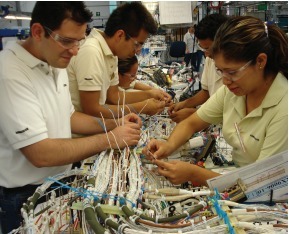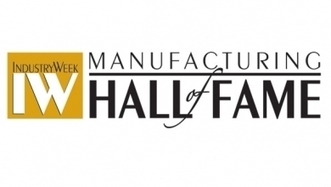Dec 18 2013
Rewarding Employees — but how? | Bodo Wiegand’s Watch
 Bodo Wiegand heads the Lean Management Institute, which is the German affiliate of the Lean Enterprise Institute. I just received the latest issue of his newsletter, Wiegand’s Watch, about various means of rewarding employees. I don’t necessarily agree with all his recommendations, and would like to point out a few key points:
Bodo Wiegand heads the Lean Management Institute, which is the German affiliate of the Lean Enterprise Institute. I just received the latest issue of his newsletter, Wiegand’s Watch, about various means of rewarding employees. I don’t necessarily agree with all his recommendations, and would like to point out a few key points:
- The way symbolic rewards are perceived varies with the national culture. For example, handing out plaques at all-hands meetings works in the US but can backfire in France. Symbolic rewards work, but you have to be sensitive about which ones are appropriate in your context. Wiegand’s context is Germany.
- When granting tangible awards, you need to consider the long-term effects on behavior, and particularly on the willingness of people to work as teams. You have to think through how a particular scheme will play out, and be on the lookout for unintended consequences.
- The basis for granting awards must not be a spike in performance that could be due to luck. It must be a permanent improvement due to clear, specific and identifiable actions.
Wiegand also discusses travel awards. While it may not be perceived as a reward per se, I believe in sending members of successful Kaizen teams on factory visits. Their eyes have been trained by the Kaizen work, and, as a result, they learn more from these visits than others without this experience. As this is business travel, it does not involve significant others.
The following is a full translation from German of Bodo Wiegands’s last newsletter, :
Again and again, I am asked: “What do we do with our suggestion authors? ” or “Should we reward the Lean team? ”
Well, I personally don’t think much of spending money on Lean. I think identifying and eliminating waste is the responsibility of each individual and of the teams that work together. On the other hand, incentives can be a strong motivating factor for humans. Why give them up? But money only has a short -term effect.
For everyone, visible signs of recognition have a much greater effect. It starts with the information board in the entrance , in front of which everybody passes. There, for each team you can show audit smilies or audit results. or the number of improvement ideas implemented. Sometimes, you see this. But why not use, for example, parking spaces as rewards?
How does that work?
The parking lot is visible to all, and therefore well suited to show awards and recognition . In the parking lot, you can make success visible, in the form of a reserved space next to the General Manager and the name on a small sign — it works.
Travel awards also work – but not as well.
If you award a trip, it should be to the whole team and involve their relevant others . If it is only among the colleagues , it is taken rather badly with the family. But a trip together together with your partner, with sufficient separation from the other team members , will be perceived as an outstanding reward and rated as positive. This , of course, builds up the pressure to get it again .
Car rewards can also be a highly effective , but only among employees who have company cars. For this you only need to amend the rules for granting company cars:
- Each company car has a plate showing the type of engine. This you should not do without .
- Each company car is grante to anemployee for only 1 year and then re-assigned based pm performance and goal achievement.
The best gets the biggest motor , the second and third best the somewhat smaller and the rest of the “normal” engine for the car class.
Believe me, it will be noticed, not only at work but also at home by the partner and children. And the downgrade to a smaller engine will also be noticed by the neighbors .
In one company, we have used this to bring the sales in full swing. Because the owner was thrilled by the idea, but expressed concerns about enforcing this with long-serving employees , we have made a car available to partners – with the same gradations in category,engine performance, and brands.
You can not imagine what happens when, after one year, the partner of the previous sales aces had to switch from the premium brand to a smaller car. This was visible to all , friends , family, neighbors , etc.
In the first year, this yielded a contribution margin increase of about 20%; in the next more than 15 %. A resounding success – and the additional costs of the cars for the partners – not worth mentioning .



Feb 22 2014
Chrysler WCM Academy Hosts First-Ever Awards Ceremony — WARREN, Mich., Dec. 13, 2013 /PRNewswire/ —
See on Scoop.it – lean manufacturing
Awards, and the rituals of presenting them to winners, are a tool of management communication. To give the desired message, you need to think through what you give the awards for, who you give them to, and the mix of tangible and symbolic rewards attached.
Chrysler awards categories are not all self-explanatory, and there some that I just don’t understand. The name of the awards, ETTEE, stands for “Excellence, Talent, Togetherness, Energy, Etc.”
There are no awards under the “Etc.” heading. All the “Talent” awards are given to individuals for “Highest Level of Project Savings.” In other words, the only form of talent recognized is that of individuals to reduce costs.
Under “Excellence,” you have more individual awards for “Trainer of the Year,” “Facilitator of the Year,” and “Most Projects Tracked by an Individual.”
Under “Togetherness,” you have awards for plants and teams: “HHH Best in Class,” “Highest Percentage of People Involved,” and “Excellence in Joint Leadership,”
Under “Energy,” you have plant awards for “”Highest Percentage of Projects Tracked by Plant, ” and “Most Hosted Plant.” and and individual awards for “Most Training Hours Completed.”
For the “person of the year” type of awards, the name gives no indication of the evaluation criteria, and perceptions of fairness may be as difficult to achieve as in Olympic figure skating.
On the other hand, awards given based on metrics — like cost savings, percentage of people involved, or number of hours of training taken — have objective criteria that individuals can understand and pursue. The key issue here is whether you really want your employees to do that.
See on www.prnewswire.com
Share this:
Like this:
By Michel Baudin • Management 0 • Tags: Award Ceremonies, Awards, Chrysler, WCM, World Class Manufacturing